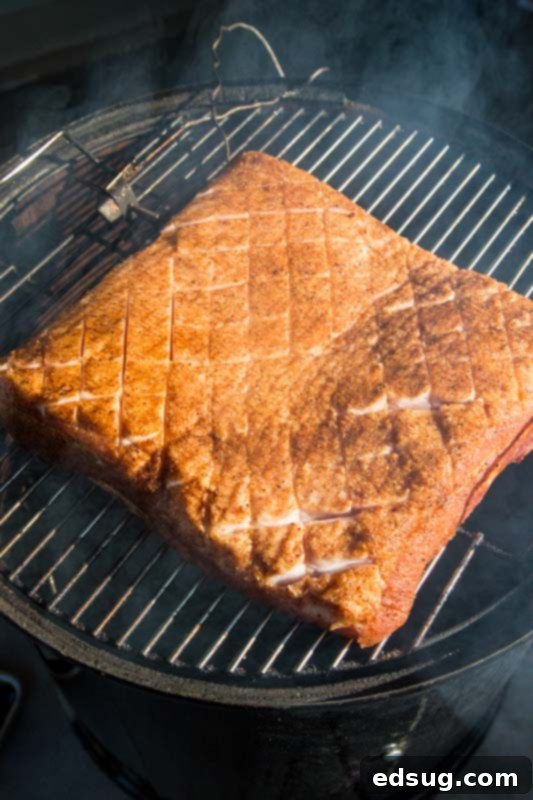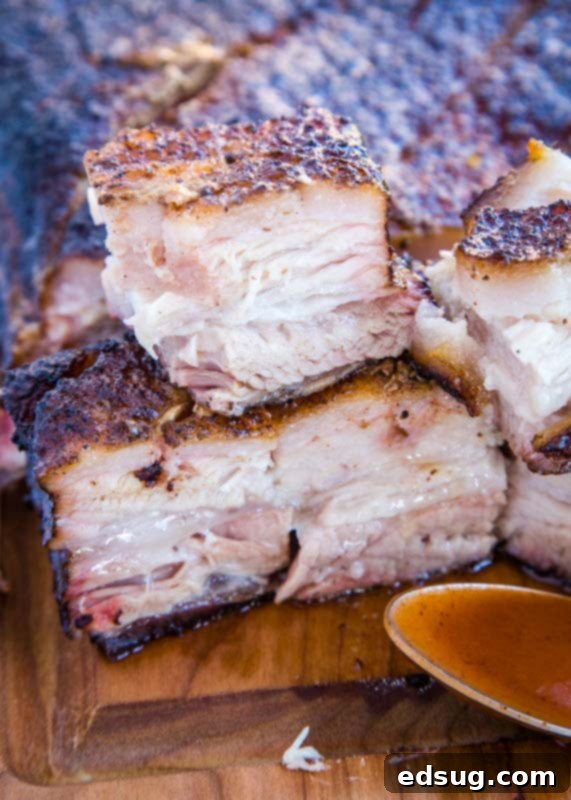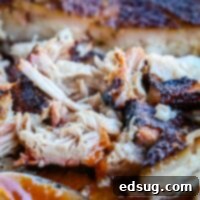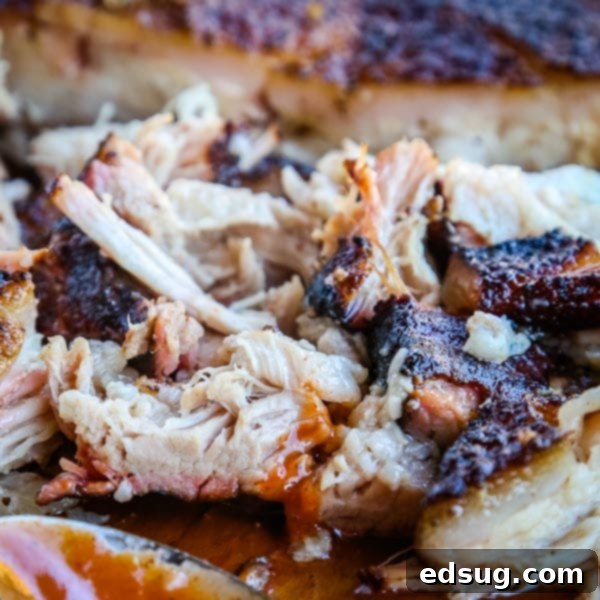Smoked Pork Belly: The Ultimate Guide to Tender, Juicy Perfection
Prepare yourself for a culinary revelation with Smoked Pork Belly – an unbelievably tender, rich, and juicy cut of pork that will forever change your perception of barbecue. Cooked “low and slow” on the smoker and generously seasoned with a flavorful dry rub, this recipe transforms humble pork belly into a melt-in-your-mouth delicacy. It’s surprisingly easy to achieve, leaving you wondering why you haven’t indulged in this smoky masterpiece before.
Smoked pork belly offers an unrivaled depth of flavor and an irresistibly tender texture, boasting that perfect balance of smoky goodness and succulent meat. Whether you plan to slice it thick for hearty sandwiches, cube it for crispy burnt ends, or serve it as a show-stopping main course, this versatile cut elevates any meal into something truly extraordinary when kissed by the smoke of a patiently tended smoker.

My journey into smoking pork belly began when my husband brought home a substantial slab from Costco. Intrigued, I decided to tackle the challenge myself. And let me tell you, that first experience was nothing short of life-changing! The resulting pork was the most tender, incredibly juicy, and flavor-packed cut I had ever tasted. It demonstrated just how rewarding a patient, “low and slow” cooking process can be.
This method requires time and patience, a commitment that often makes it difficult for restaurants to achieve the same unparalleled results. But trust me, the wait is absolutely worth it. The transformation of pork belly into this incredibly succulent dish makes it one of the best pork preparations you will ever experience. It’s more than just a meal; it’s an event, a celebration of flavor and texture that proves good things come to those who wait.
What You’ll Need for Smoked Pork Belly
To embark on your smoked pork belly adventure, you’ll need a few key ingredients. While the full printable recipe card is available at the bottom of this post, here’s a quick overview of the essentials:
- Pork Belly: The star of our show! Look for a good quality, thick slab, ideally with the skin removed unless you specifically want crackling (though this recipe focuses on tender meat).
- Dry Rub: A good quality dry rub is paramount for building flavor. I consistently use The Best Dry Rub for all my smoked meats due to its fantastic blend of spices that perfectly complements pork. However, feel free to use your favorite spice blend, ensuring it has a good balance of sweet, savory, and a hint of heat.
- Apple Juice: This is a secret weapon for maintaining moisture and adding a subtle fruity note during the smoking process. You can also use water, apple cider vinegar, or even beer for spritzing, but apple juice is highly recommended for its flavor contribution.
Where To Buy The Best Pork Belly
Finding a quality slab of pork belly is the first step to success. We almost always procure ours from Costco. They typically offer large slabs, ranging anywhere from 8 to 14 pounds. These larger cuts are incredibly versatile; you can easily divide them into smaller portions for individual smoking sessions and freeze the rest for future use, or smoke a whole slab for a substantial gathering.
If Costco isn’t an option, Asian markets are another excellent resource. While they often carry pork belly, it’s frequently pre-cut into smaller pieces. Don’t hesitate to speak with their butchers – they might be able to order a larger, whole slab for you if you specify your needs. Furthermore, your local butcher is an invaluable resource. Butchers often have access to a much wider variety of cuts than what’s displayed in their cases and can custom-cut pork belly to your desired specifications. Building a relationship with a good butcher can open up a world of quality meats.
When selecting your pork belly, look for a piece with an even distribution of meat and fat. A good balance ensures maximum flavor and tenderness. The fat cap should be firm and white, and the meat should be a vibrant pink color. Avoid pieces that have discolored fat or appear dry.

How To Smoke Pork Belly: A Step-by-Step Guide
Achieving perfectly smoked pork belly is a methodical process that rewards patience. Follow these steps for the most tender and flavorful results. Remember, the full printable recipe card with exact measurements and times is located at the bottom of this page.
- Prepare the Pork Belly: Scoring for Max Flavor & Tenderness: Lay your pork belly on a large cutting board, fat side up. Using a sharp knife, make diagonal cuts every 2 inches across the fat, cutting just through the fat layer but not into the meat. Rotate the pork belly 90 degrees and repeat the diagonal cuts in the other direction. This creates a beautiful diamond pattern in the fat. This crucial step allows the fat to render more easily and consistently during the long cooking process, resulting in a much more tender bite. It also creates more surface area for the dry rub to penetrate, infusing the meat with deeper flavor.
- Season Generously: Once scored, generously season all sides of the pork belly with your chosen dry rub. Don’t be shy – pork belly can handle a good amount of seasoning. Press the rub firmly into the scored fat and meat, ensuring an even coating. As mentioned, I prefer our Dry Rub for Ribs seasoning blend as it pairs exceptionally well with pork.
- Rest and Prepare the Smoker: Allow the seasoned pork belly to sit out at room temperature for about 30-60 minutes while you get your smoker ready. This helps the meat absorb the rub and brings it closer to cooking temperature for more even results. Preheat your smoker to a consistent 225 degrees F (107 degrees C). For smoking pork, especially pork belly, I highly recommend using apple wood chips or chunks. Applewood imparts a sweet, mild, and fruity smoke flavor that beautifully complements the richness of the pork.
- Begin the Smoke: The Low and Slow Phase: Place the seasoned pork belly directly on the smoker grates, fat side up. Close the lid and let the magic begin. During this initial phase, the pork will slowly absorb the smoky flavor and begin to render its fat. Every hour, you have the option to spritz the meat with apple juice (or water/cider vinegar). This spritzing helps to keep the surface moist, prevents it from drying out, and contributes to a darker, slightly softer, and more appealing bark on the exterior. While optional, we’ve enjoyed the results both with and without spritzing, finding that spritzing does enhance the final product.
- The Stall and The Wrap: Continue smoking until the internal temperature of the pork belly reaches approximately 165°F (74°C). At this point, you’ll likely hit the “stall” – a phase where the internal temperature plateaus for an extended period. To push through this and accelerate the cooking, wrap the pork belly tightly in foil or butcher paper. Before sealing, pour in a little more liquid, such as another 1/2 cup of apple juice, to create a moist, steamy environment that will further tenderize the meat.
- Cook to Perfection: Return the wrapped pork belly to the smoker and continue cooking until its internal temperature reaches 195°F (91°C). This higher temperature is crucial for breaking down the collagen and connective tissues in the pork belly, ensuring that melt-in-your-mouth tenderness we’re aiming for.
- Rest and Serve: Once the pork belly hits 195°F, carefully remove it from the smoker. Allow it to rest, still wrapped, on a cutting board for at least 30 minutes, or even up to an hour. This resting period is vital, as it allows the juices to redistribute throughout the meat, resulting in an even more succulent and flavorful final product. After resting, unwrap, slice, cube, or shred, and serve immediately!

How Long To Smoke Pork Belly
Just like with any type of smoked meat, the cooking time for pork belly can vary significantly. Factors such as the thickness of your meat, the consistency of your smoker’s temperature, and even external weather conditions can influence the duration. As a general guideline, a 4-5 pound piece of pork belly typically takes around 10 hours from start to finish using the “low and slow” method at 225°F.
However, relying solely on time can be misleading. The absolute key to knowing when your smoked pork belly is truly done is to use a reliable thermometer probe. This allows you to constantly monitor the internal temperature of the meat. I highly recommend a high-quality thermometer like the one from Thermoworks, which tracks both the meat and smoker temperatures simultaneously. It’s an invaluable tool for any grilling or smoking enthusiast. I like to remove the pork belly from the smoker when the thermometer consistently reads 195°F (91°C). This temperature ensures that the collagen has completely broken down, resulting in that incredibly tender, fall-apart texture we’re aiming for.
Essential Tools for Smoking Pork Belly
While the ingredients are few, having the right tools can make your smoking experience much smoother and more successful:
- Smoker: Any type of smoker (pellet, electric, charcoal, offset) capable of holding a consistent low temperature (225°F) will work.
- Wood Chips/Chunks: Applewood is highly recommended for its mild, fruity flavor profile that complements pork beautifully. Other fruitwoods like cherry or pecan also work well.
- Sharp Knife: Essential for scoring the pork belly fat cap with precision.
- Meat Thermometer: A high-quality leave-in probe thermometer (like the Thermoworks option mentioned above) is non-negotiable for accurately monitoring internal meat temperature and ensuring perfect doneness.
- Spritz Bottle: For applying apple juice or other liquids to keep the meat moist during smoking.
- Foil or Butcher Paper: For wrapping the pork belly to help it push through the stall and tenderize further.
- Cutting Board: A large, sturdy cutting board for prep and serving.

Creative Ways To Serve Smoked Pork Belly
Once that beautifully smoked pork belly comes off the smoker, it will be incredibly juicy, tender, and bursting with flavor. The possibilities for enjoying it are truly endless. Its rich taste and succulent texture make it a versatile ingredient for a myriad of delicious dishes:
- Pork Belly Tacos: Cut the smoked pork belly into small cubes, crisp them up lightly in a pan if desired, and serve them in warm tortillas with your favorite toppings like pickled onions, cilantro, and a squeeze of lime for an unforgettable taco experience.
- The Ultimate Pulled Pork: The tenderness of smoked pork belly makes it perfect for shredding. Simply pull it apart with forks for the most delicious, rich, and flavorful “pulled pork” you’ve ever encountered.
- Standalone Delicacy: Enjoy it on its own, perhaps topped with your favorite homemade barbecue sauce or a simple glaze, as a decadent main course. The rich flavor needs little embellishment.
- Gourmet Sandwiches: Pile shredded or sliced smoked pork belly onto a toasted bun for an elevated pulled pork sandwich. Add coleslaw or pickles for crunch and tang.
- Topping for Baked Potatoes: Transform a simple baked potato into a hearty meal by topping it generously with cubed or shredded smoked pork belly. Add cheese, sour cream, and chives for a truly satisfying dish.
- Leftover Quesadillas: Don’t let any leftovers go to waste! Smoked pork belly makes an incredible filling for quesadillas. Combine it with cheese and your favorite veggies for a quick and flavorful meal.
- Pork Belly Burnt Ends: For an extra special treat, cut the smoked pork belly into 1-inch cubes after wrapping, toss with a little more rub and barbecue sauce, and return them to the smoker for another hour or two until caramelized and sticky. These “meat candy” burnt ends are legendary!
Slathering on your favorite barbecue sauce truly completes this heavenly dish. This smoked pork belly recipe, though simple in its execution, yields outstanding results. All it requires is a willingness to dedicate a few hours to the smoker, perhaps with a refreshing drink in hand, and the patience to let the smoke and low heat work their magic.
What To Serve With Smoked Pork Belly
The rich, savory flavor of smoked pork belly pairs wonderfully with a wide array of side dishes. You can go for classic barbecue pairings or opt for lighter, fresher accompaniments to balance the richness:
- Traditional Barbecue Sides: Embrace the full barbecue experience with staples like moist Cornbread or sweet and savory Baked Beans. These hearty sides perfectly complement the smoky flavor.
- Fresh and Tangy Sides: To cut through the richness of the pork belly, consider brighter, more acidic options. A refreshing Apple Cranberry Coleslaw provides a delightful crunch and tartness. An Orzo Pasta Salad, perhaps with a vinaigrette dressing, also offers a lighter contrast.
- Roasted Vegetables: Simple roasted asparagus, Brussels sprouts, or even grilled corn on the cob can be fantastic companions.
- Potatoes: Beyond baked potatoes, consider creamy mashed potatoes or crispy roasted potato wedges.
Storage and Reheating Tips
Unless you’re feeding a very large crowd, you’re almost guaranteed to have delicious leftovers, as a single slab of pork belly yields a substantial amount of meat. Proper storage is crucial to maintaining its quality and flavor.
- Refrigeration: Allow the smoked pork belly to cool completely to room temperature before storing. Place it in an airtight container and refrigerate for up to 4 days. This ensures it remains fresh and prevents bacterial growth.
- Freezing: For longer storage, you can freeze leftover smoked pork belly for up to 3 months. Wrap individual portions tightly in plastic wrap, then place them in a freezer-safe bag or container. Label with the date. When you’re ready to enjoy it again, simply thaw it in the refrigerator overnight.
- Reheating: To reheat, slice or cube the pork belly and gently warm it in a skillet over medium-low heat until heated through. You can add a splash of apple juice or water to help keep it moist. Alternatively, wrap it in foil and reheat it in an oven preheated to 300°F (150°C) until warm. Avoid high heat, which can dry out the meat.
Frequently Asked Questions (FAQs) About Smoked Pork Belly
- Do I have to score the pork belly?
Scoring the fat cap is highly recommended. It allows the fat to render more efficiently, resulting in a crispier exterior and more tender meat. It also helps the dry rub penetrate deeper for enhanced flavor. While not strictly mandatory, it significantly improves the final texture and taste. - What kind of wood chips are best for smoking pork belly?
Applewood is generally considered the best choice for pork belly, offering a mild, sweet, and fruity smoke that complements the richness of the meat without overpowering it. Cherry, pecan, or even a mix of apple and oak can also produce excellent results. Avoid overly strong woods like mesquite unless you prefer a very intense smoky flavor. - Can I make smoked pork belly burnt ends with this recipe?
Absolutely! Smoked pork belly burnt ends are a highly sought-after delicacy. To make them, follow the recipe up to the point where the pork belly reaches 195°F and has rested. Then, cut the pork belly into 1-1.5 inch cubes. Toss the cubes with a little more dry rub and your favorite BBQ sauce. Return them to the smoker (or an oven) at a slightly higher temperature, around 275-300°F (135-150°C), for another 1-2 hours, stirring occasionally, until the sauce has caramelized and the burnt ends are tender and sticky. - How do I prevent my pork belly from drying out?
Several factors contribute to moist pork belly: low and slow cooking, spritzing with apple juice or water every hour, wrapping the meat once it hits the “stall” (around 165°F) with additional liquid, and most importantly, pulling it off the smoker at the correct internal temperature (195°F) and allowing it to rest adequately before slicing. The fat content in pork belly also naturally helps keep it moist.
More Delicious Smoked Recipes
If you’ve enjoyed the process of smoking pork belly, you might be ready to explore other fantastic smoked dishes:
- Smoked Whole Chicken
- Smoked Baby Back Ribs
- Smoked Pork Butt
- Smoked Tri Tip
- Smoked Country Style Ribs

Conclusion
Smoking pork belly is a truly rewarding experience that yields some of the most flavorful and tender pork you’ll ever taste. While it requires patience and a “low and slow” approach, the steps are straightforward and the results are consistently spectacular. From scoring the fat to monitoring the internal temperature, each step contributes to the perfect bark, succulent interior, and rich, smoky flavor. Embrace the process, enjoy the aroma, and prepare to impress yourself and your guests with this incredible dish. Happy smoking!

Smoked Pork Belly Recipe
Smoked Pork Belly – the most tender and juicy pork you will ever have! It is cooked low and slow on the smoker and seasoned with a delicious rub. Super easy, you will wonder why you have never tried it before!
By: Erin Sellin
Prep Time: 10 mins
Cook Time: 9 hrs
Total Time: 9 hrs 10 mins
Servings: 8
Course: Dinner Recipes
Cuisine: American
Rating: 4.80 from 5 votes
Ingredients
- 4 pounds pork belly
- 1/3 cup Dry Rub
- Apple Juice, or water (for spritzing and wrapping)
Instructions
- Place pork belly on a large cutting board. Start at one end and make diagonal cuts every 2 inches through the fat, just to the meat. Rotate the pork 90 degrees, and do the same thing in the other direction. You’ll end up with 2-inch diamonds cut into the fat.
- Generously season all sides of the pork with the dry rub.
- Let the pork sit out at room temperature for about 30-60 minutes while you get your smoker ready. Heat the smoker to 225 degrees F (107 degrees C).
- Place the pork belly on the smoker grates, fat side up, and close the lid.
- Every hour, spritz the meat generously with apple juice to keep it moist and promote bark formation.
- Once the meat reaches an internal temperature of 165 degrees F (74 degrees C), carefully wrap it tightly with foil (or butcher paper). Pour about 1/2 cup of apple juice in with the meat before sealing the wrap.
- Return the wrapped pork belly to the smoker and continue cooking until the meat reaches an internal temperature of 195 degrees F (91 degrees C).
- Remove from the smoker and let it rest, still wrapped, for at least 30 minutes before unwrapping, slicing, and serving!
Notes
The Best Dry Rub is my absolute favorite for this recipe, delivering exceptional flavor every time.
Nutrition
Nutrition information is automatically calculated, so should only be used as an approximation.
- Calories: 677kcal
- Carbohydrates: 4g
- Protein: 52g
- Fat: 49g
- Saturated Fat: 18g
- Polyunsaturated Fat: 29g
- Cholesterol: 191mg
- Sodium: 214mg
- Sugar: 3g
Like this recipe? We’d love to hear from you! Leave a comment below and share your experience.
I created a fun group on Facebook, and I would love for you to join us! It’s a place where you can share YOUR favorite recipes, ask questions, and see what’s new at Dinners, Dishes and Desserts (so that you never miss a new recipe)!
Be sure to follow me on Instagram and tag #dinnersdishes so I can see all the wonderful DINNERS, DISHES, AND DESSERTS recipes YOU make!
Be sure to follow me on my social media, so you never miss a post!
Facebook | Twitter | Pinterest | Instagram
